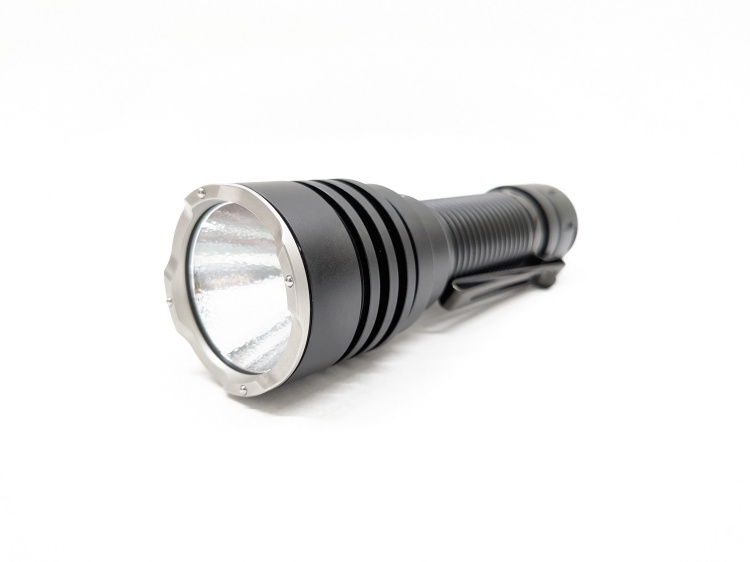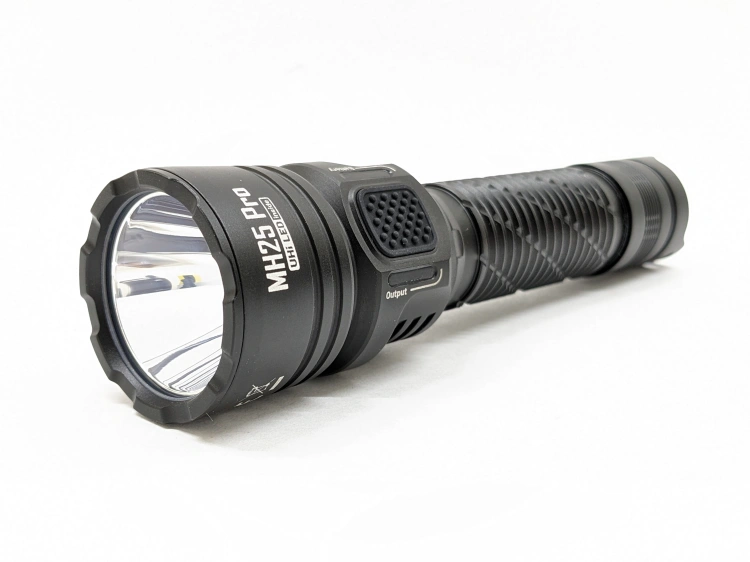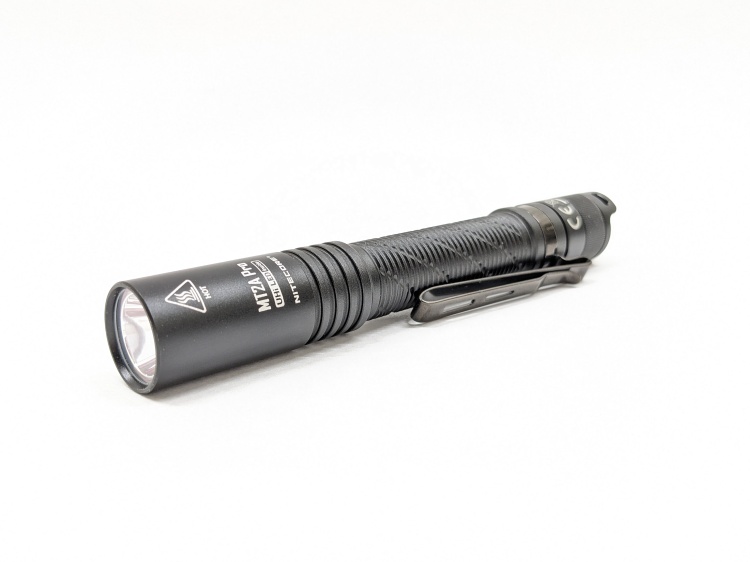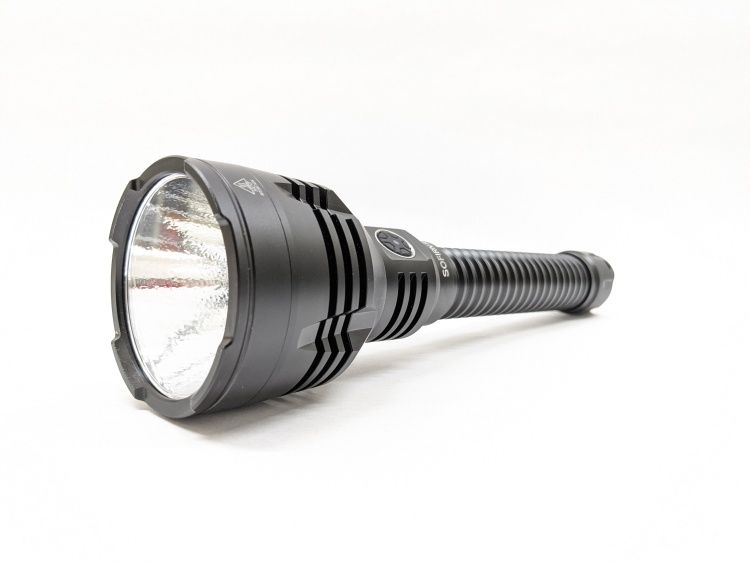Contents
- Pricing & Availability
- ESKTE
- What comes in the box?
- Design & Construction
- Size & Measurements
- User Interface
- Emitter & Beam
- Mode Chart
- Runtime
- Driver & Regulation
- Switch
- Carry & Ergonomics
- Batteries & Charging
- Competition
- Conclusion
Safety Issue with First Batch
The first batch of H150’s had an issue where the reverse polarity protection button was connected to ground. Inserting a battery backward would cause a short circuit that could be dangerous. The issue has been fixed and the faulty units have been recalled so H150 is safe to order. The updated version says “V2” on the driver board, as shown in the driver section.
Pricing & Availability
Skilhunt sent me this light in exchange for an honest review. Here is the official product page where you can see current pricing. I expect it will also be available from other stores like Amazon and Killzone Flashlights soon. Shoutout to Killzone for their standing 10% off code “reddit” for r/flashlight users!
ESKTE
Skilhunt has decided to transition its brand name to “ESKTE”, so you’ll see that a lot in this review. I think that’s a bad decision because “Skilhunt” has some brand recognition that’s been built over the years and it actually sounds like words in English. “ESKTE” just reads like another cheap Chinese brand with a gibberish name selling low-quality products all over Amazon. I believe the correct pronunciation is “ess-kay-tee”. While it’s an unfortunate change, I’m sure they’ll continue to build high-quality products under the name “ESKTE”.
What comes in the box?
H150 comes in a retail-ready box with a clear window and a pegboard hanger. It’s made of printed cardboard and has a thin vacuum-molded insert inside to hold the light in place. The following items are included in the box:
- The light itself
- Battery (inside the light)
- Headband (unassembled)
- USB-A to magnetic charging cable
- Pocket clip
- Wrist lanyard
- Spare O-rings
- User manual
Design & Construction
The design is in line with Skilhunt’s other headlamps, just shrunken down to 14500 size. It’s a narrow body tube with a slightly flared tailcap and right-angle head. The button is on the side and a magnetic charging contact is on top. It’s a bit funny looking but very functional. I like the silver accents from the retaining rings.
I’m not a fan of the excessive branding though. Just one “H150” and “Skilhunt” or “ESKTE” would have been fine, like the one below the optic. But the entire side of the head is plastered with writing, including a URL which should never be included on the outside of a product. It’s just tacky.
The build quality feels nice and is satisfactory overall. The anodizing is matte and just a bit chalky. The threads are smooth enough, trapezoid-cut, anodized, and lubricated. Unfortunately, I wasn’t able to unscrew the head, even with grippy gloves, so it may be glued on.

Size & Measurements
Lumintop FW3A | Skilhunt H300 | Skilhunt H150 | Acebeam Pokelit AA Cu | Olight WM2

| Measurement | Measured (mm) |
|---|---|
| Bezel Diameter | 17.5 |
| Maximum Head Diameter | 25.7 |
| Length | 79.8 |
| Switch Diameter | 10 |
| Switch Proudness | 1.1 |
| Optic Diameter | 15.0 |
| Optic Height | 9.2 |
| MCPCB Size | 12-ish? |
| Body Tube Diameter (internal) | 15.0 |
| Body Tube Diameter (maximum) | 19.5 |
| Body Tube Diameter (mode) | 18.0 |
| Body Tube Length | u/m |
| Ride Height (sticking out of pocket) | 3.9 |
| Pocket Clip Space (for pants material) | 2.5 |
| Pocket Clip Space (at mouth) | 3.0 |
| Pocket Clip Width | 6.1 |
| Pocket Clip Thickness | 0.8 |
| Pocket Clip Slot Width | 3.7 |
| Pocket Clip Slot Diameter | 16.7 |
| Tailcap Diameter | 20.0 |
| Tailcap Length | 13.2 |
| Driver Diameter | u/m |
| Included Battery Length | 50.1 |
| Included Battery Diameter | 14.3 |
Weight without battery: 34g
Included battery weight: 20g
Pocket clip weight: 4g
Main headband weight: 35g
Headband top strap weight: 13g
Total weight: 106g
User Interface
This is a near-perfect UI with all the functions you need and few complicated extras.
The actions are # of presses followed by a hold (H) or a release (C). So, “1C” is one click and release. “2H” is two clicks but you hold down the last one.
| State | Action | Result |
|---|---|---|
| Off | 1C | On (mode memory) |
| Off | 1H | Moonlight |
| Off | 4C | Lockout |
| Moonlight | 1H | Toggle the Moonlight setting |
| Moonlight | 2H | Go to memorized middle mode |
| Any | 2C | Turbo |
| Turbo | 1H | Toggle the Turbo setting |
| On | 1C | Off |
| On | 1H | Cycle mode |
| Any | 3C | Blinkies (mode memory) |
| Blinkies | 2C | Cycle mode (strobe, SOS, beacon) |
| Lockout | 1H | Momentary Moonlight |
| Lockout | 2C | Toggle lockout switch beacon on/off |
| Lockout | 4C | Unlock to Moonlight |
What they got right:
- Clicking turns the light on/off and holding the button changes modes. That’s the way almost all e-switch flashlights should work. It’s intuitive and quick.
- The common shortcuts work. Moonlight, Turbo, and blinkies all have shortcuts that work the same way as most other lights. They work very well and there’s no learning curve for these when switching lights.
- Shortcuts don’t memorize modes. Moonlight, Turbo, and blinkies all have their own direct shortcut, so you can access them quickly without overriding your memorized mode.
- There are 3 middle brightness levels plus Moonlight and Turbo, which is the right amount. Enough to have options but not so many that it’s cumbersome to use.
- Lockout is 4 clicks. That’s complex enough not to be done or undone by accident, but is still easy and quick.
What they got wrong:
- The secondary Turbo and Moonlight are superfluous. When I want Turbo, I want the brightest mode. When I want Moonlight, I want the dimmest mode. Having a slightly dimmer Turbo and a slightly brighter Moonlight is not useful to me. Sometimes I want to go from Moonlight to Low mode, but here I can’t because 1H just goes to the slightly brighter moonlight mode. This isn’t a huge deal, but it’s annoying.
- There’s no way to go from Moonlight to low. 1H from Moonlight should go to low mode, but here it goes to the unnecessary brighter moonlight mode. If the secondary Moonlight and Turbo modes were eliminated, this would not be an issue.
- Beacon blinks too fast. It’s a 50% on, 50% off duty cycle every 1 second. Most beacon modes blink the LED on for 1-200 milliseconds every 3-5 seconds and that makes them last much longer and be less bothersome to others.
Emitter & Beam
H150 is available with two different LED options: a cool white Cree XP-L2 in standard CRI (~70) CRI and a neutral white (4500K) Nichia 519A in high CRI (R9080). I chose the 519A for its superior color properties, but the XP-L2 will provide more brightness and cooler running temperatures. The LED sits behind a beaded TIR optic. There’s no glass lens in front of the optic but I don’t think that’s strictly necessary on floody lights like this because scratches won’t affect the beam.


I was able to remove the bezel with a super grippy glove. Underneath the optic, I found a little white cone of unknown purpose and a new MCPCB design. This design screws into the shelf rather than relying on the pressure of the optic, which is an improvement over older Skilhunt designs. I think this is a special size of MCPCB so any emitter swaps will probably have to be done via reflow. You can also see the 519A LED here.

The beam is soft with no hard edges or artifacts in the hotspot. The spill is dim and soft so it makes the beam feel a little narrower than most headlamps. The hotspot is wide enough to still be useful though. I’m happy with the beam shape for striking a good balance between throw and flood instead of going pure flood like many headlamps do.

In the beamshots below, the concrete corner to the right of the hotspot is 39M away and the power pole in the center is 185M away.






Mode Chart
Disclaimer: All of my measurements are taken at turn-on. Lumen measurements were taken on a Texas Ace 3.5″ Lumen Tube. A candela measurement was taken at 10 meters with an Opple Light Master III on the highest brightness, and other candela figures were calculated relative to that. CRI, CCT, & DUV data were taken for each mode from a few feet away at the center of the hotspot with the Opple Light Master and Waveform DUV Calculator. Runtime tests were performed with the Ceilingbounce app on my smartphone. All of these tests were performed with a fully charged included 14500 battery unless otherwise specified. I cannot measure moonlight directly, so moonlight readings are calculated based on the brightness relative to the next-lowest mode. None of this is professional equipment, so take all of these measurements with a grain of salt.

Above are the official specs, followed by my own measurements below.
| Level | Lumens | Candela | Throw (Meters) | CRI (Ra) | Color Temp. (K) | DUV (Tint) |
| Turbo | 480 | 1700 | 82 | 97 | 4480 | -0.0004 |
| High | 230 | 815 | 57 | 97 | 4440 | 0.0005 |
| Medium | 70 | 248 | 31 | 98 | 4380 | 0.0006 |
| Low | 10 | 35 | 12 | 98 | 4340 | 0.0004 |
| Moonlight | 0.1 | <1 | 1 | 98 | 4280 | 0.0001 |
Note: I chose not to measure L1 or T2 because I think they are superfluous. Virtually everyone buying this light will use the brighter Turbo and the dimmer Moonlight.
Mode Spacing: is good. Low could stand to be a little lower perhaps. That’s ignoring the superfluous L1 and T2 modes.
Runtime

Performance: Turbo is exactly as advertised at 480 lumens. It lasts for 1 minute before a timed stepdown to a stable 230 lumens. That’s extremely impressive sustained output for such a small light with a high CRI LED. NiMH performance is excellent too with a stable 160 lumens for an hour before stepping down to extend battery life. Great work, Skilhunt.
Thermal regulation: There is a timed stepdown from Turbo and no other thermal regulation whatsoever. I would like to see active thermal regulation in a future version that responds to temperature to maximize brightness.
LVP (Low Voltage Protection): there is low voltage protection built into the light for both li-ion and ni-mh batteries so you can use unprotected batteries safely. The light will blink off for a split second occasionally when the battery is low to warn the user. The light can be re-activated briefly after low voltage shutoff in an emergency.
Driver & Regulation

H150 is compatible with all button-top AA-sized batteries as far as I know. That’s Li-ion, NiMh, Alkaline, and Lithium Primary. Supporting low-voltage batteries like NiMH and Alkaline with a 3-volt LED means that this must be a boost driver for those chemistries. Fellow reviewer and Reddit user Zak did some current testing and found that it’s a boost-linear driver. The lower-voltage batteries use the boost side and the higher-voltage 14500 battery uses the linear side. I’m impressed it can sustain such high output on a 14500 with a linear driver, but buck-boost would have been better.

Regulation is not perfect on the included 14500 battery but it’s excellent compared to most multi-chemistry AA lights. None of the modes are significantly affected until the battery starts to get low, but then all the modes are affected. Regulation is also excellent on an Eneloop NiMH cell (see the runtime graph in the previous section). A light being reasonably well-regulated on both NiMH and Li-ion batteries is extremely rare so this is very impressive.
Note: All regulation measurements are taken at turn-on so they do not reflect any thermal or low voltage stepdowns that may occur. A value of 0 indicates low voltage shutoff immediately upon activation.
PWM: No PWM is visible to my eyes or camera, nor audible to my ears.
Parasitic Drain: 12 microamps with the included battery, which will take 7 years to drain it. 4 microamps with an Eneloop, which will take 50 years to drain it. That’s the least parasitic drain I have ever seen. NOTE: using the lockout indicator function will massively increase the parasitic drain and will drain the included battery in about 1 month. 2 clicks within lockout mode will enable/disable it.
Switch

H150 uses an electronic switch mounted on the side of the head, rather than at the top of the head like many right-angle lights. This switch placement isn’t as good for handheld use but it’s much better for headlamp use. It positions the switch to be pinched between the user’s index finger and thumb, the most ergonomic switch position for a headlamp. It’s tactile, clicky, and feels nice. It’s also easy to find even in the dark.

The switch is covered by a translucent rubber boot, and there’s a backlight underneath that serves as a battery indicator. It lights up for 5 seconds after the light is activated. Constant blue means the light is 80-100% charged. Blinking blue means the light is 50-80% charged. Constant red means 20-50% charge. Blinking red means 0-25% charge and it will continue blinking until the light is turned off. This battery indicator system requires a little bit of memorizing but it works well enough. It only works with Li-ion 14500 cells though, not any other chemistries (Alkaline, NiMH, etc).
Carry & Ergonomics
H150 is very small so it’s not particularly ergonomic to use. It’s so lightweight that it doesn’t really matter though. The switch is on the side which is better for headlamp use than handheld use. It’s ergonomic enough for short EDC handheld use but if I planned to be out and holding a light for a long time I’d want something more hand-filling and ergonomic.

Three carry methods are included in the box: a headband, a pocket clip, and a wrist lanyard. The wrist lanyard is a little nicer than the ones included with many other lights. I’m sure it’ll do the trick if you’re a lanyard person.
Headband: The headband is an evolution of the Skilhunt HB3 headband they’ve been including with their 18650/18350 headlamps for a few years. It’s modular so you can remove the top strap if you want, and even take the light-mount off and attach it to another headband or strap. There’s a bead of silicone inside the band for grip, and the outside has reflective text for safety. The clamp is very secure so the light won’t pop out by accident even if forcefully bumped.
This band differs from HB3 in two key areas: the clamp rotates 360 degrees and the clip slot has been removed. The clamp rotates so you can attach it to a backpack strap or MOLLE webbing and still be able to point the light in the direction you need. The clip slot being removed is not a big deal because you can just rotate the clip to the front or the side like in the photo below.

Initially, I thought this headband seemed a little bit complex and bulky for such a small light. However, I’ve come to realize just how much functionality and flexibility Skilhunt has baked into it. Once again they’ve made a best-in-class headband.

Pocket clip: The pocket clip is a new design and it works well. It can attach near the head or near the tail but I find near the tail to be much more useful. That allows the light to carry deep in the pocket and you can use the loop-back part of the clip to attach the light to your shirt pocket while facing the beam outward. It will scratch the finish on the light if you move it regularly though.
Magnet: There’s also a strong magnet in the tailcap that will reliably hold the light up on most ferrous surfaces. It can be removed if you don’t want the tailcap to be magnetic, but there’s no plastic spacer included to fill the void it leaves like there has been on previous Skilhunt models. The magnet inside the head for the charger is not strong enough to be useful for anything else and it cannot be removed.

Batteries & Charging

H150 supports every chemistry of AA-size battery I can think of; Alkaline, NiMH, Li-ion, Lithium primary, etc. As long as they are a button top. There’s physical reverse polarity protection so no flat tops here.
My sample came with an 800mah 14500 battery that works but it’s just OK. If you order from Skilhunt directly, you can upgrade to a “BL-110C” battery with 1100mah, a higher discharge rating, and a USB-C charging port built into it. If you order from anywhere else you will likely get this 800mah cell. I wish that BL-110 were the default/only included battery option.

Charging is facilitated by the included magnetic puck USB charging cable. The magnet end snaps onto the contacts on the head of the light for easy charging. The magnetic connection is pretty weak and finicky though. A slight jostle can cause it to lose connection. The light is fully functional while charging, even with the battery removed. Since the contacts are exposed, this may be a poor choice if you work around ferrous metal shavings regularly.


I’m delighted that Skilhunt used a standard battery here so you can still recharge your light with a normal charger if you need to, unlike another popular brand with magnetic charging (Olight). I do wish they included their USB-C 14500 so we could have a backup charging option.
Competition
Here are some lights in the same class and how they compare.
Acebeam H16: cheaper, different button location, USB-C charging battery, worse headband, end switch instead of side switch, no moonlight mode, worse regulation, marginally brighter, similar LED options
Manker E03H II: best-in-class ultra-low moonlight mode (~0.01lm on NiMH battery), end switch instead of side switch, worse headband, similar LED options, comes with slidey color diffusers, less expensive, possibly discontinued?
Olight Perun 2 Mini: more expensive, proprietary battery, better magnetic charging, simpler headband, similarly good UI, similarly good efficiency and regulation, secondary red light, no high-cri LED option, end switch instead of side switch
Skilhunt H04 RC Mini: basically the same as H150 but shorter, fatter, and uses an 18350 battery
This section is not comprehensive. If I didn’t include a particular light here, it doesn’t mean it’s bad or doesn’t deserve to be here. I simply cannot list every possible competitor.
Conclusion
Skilhunt has managed to shrink my favorite headlamp (Skilhunt H300) into a smaller, lighter package while also adding functionality. They’ve given it an excellent driver that provides unparalleled performance in this space. The headband is even more feature-packed and flexible than before. It’s bright and it stays bright despite its small size and high-CRI LED. I’ve been unimpressed by AA/14500 lights in the past and I’m honestly floored by how good this little H150 is. It’s the best in its class by a large margin and I recommend it to anyone looking for a compact headlamp or a versatile AA/14500 light.
Thanks to ESKilhunTE for sending me this light for review!






















> Sometimes I want to go from Moonlight to Low mode, but here I can’t because 1H just goes to the slightly brighter moonlight mode. This isn’t a huge deal, but it’s annoying.
Try 2H from moonlight and see what happens. 😉
LikeLike
Warning: the design will SHORT CIRCUIT with Flat Top Batteries, because the RPP post is grounded..
LikeLike